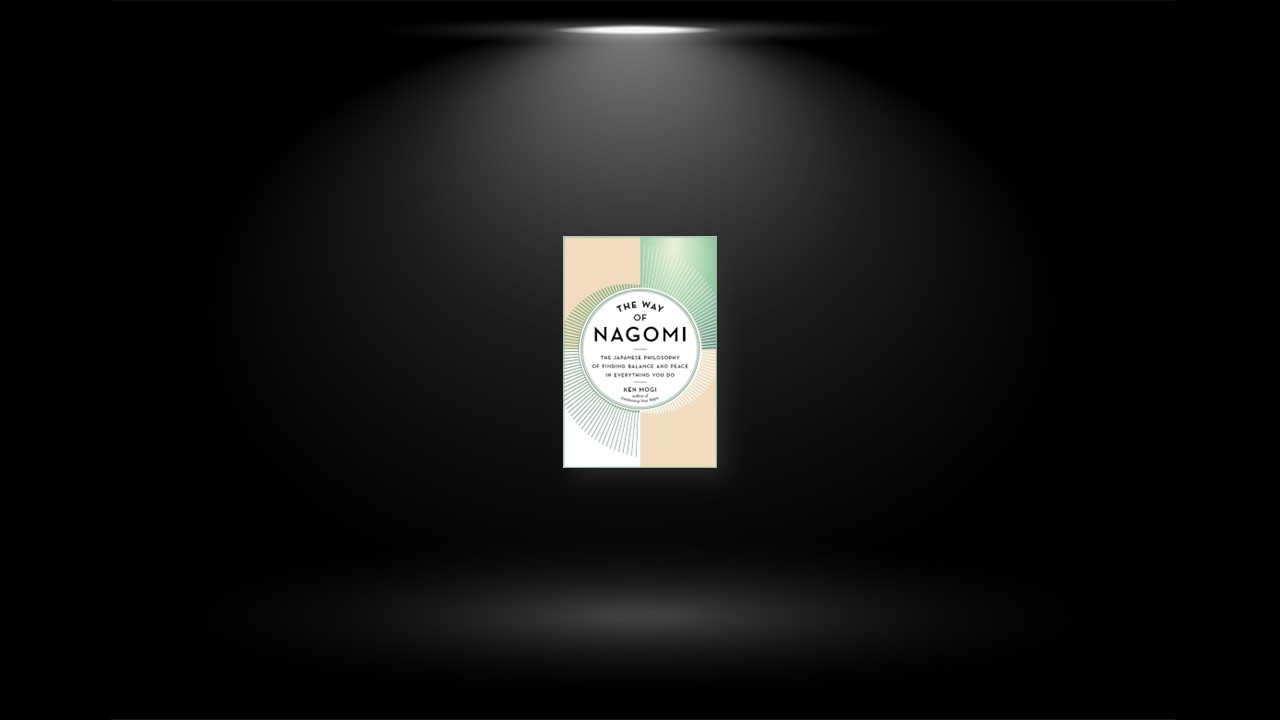Nagomi for Beginners
But first, what is nagomi? Roughly, it means balance, comfort, and calm of the heart and mind. Nagomi could be about one’s relationship with the environment, or the quality of one’s communication with other people. Nagomi may be about a well-mixed and balanced blending of materials, as in the case of cooking. Nagomi can also be about one’s general state of mind, as when one is in harmony with oneself and the world at large. Ultimately, nagomi is a state of human consciousness characterized by a sense of ease, emotional balance, well-being, and calmness.
Nagomi is considered to be the mother of important concepts such as wabi sabi, Zen, kintsugi, ichigo ichie, and ikigai. Indeed, it is not an overstatement to say that nagomi is at the pinnacle of Japanese culture and central to the Japanese philosophy of life.
Nagomi of Food
One, when cooking add ingredients without prejudice, no matter what the origin of them might be, both culturally and geographically. The nagomi of food is a very liberal attitude.
Two, blend and mix them, and try to strike a balance between the different ingredients without overriding them with a strong sauce, no matter how tasty or effective it might be. Thus, Japanese food is famous for its meticulous care and consideration of each food item on its own merit, rather than directing and forcing it into a particular taste. The nagomi of food is democratic.
Three, through the nagomi of mixing and blending, some new flavors and textures are born, often with unexpected and surprising results. The nagomi of food is a creative process. Matcha ice cream, which blends ice cream (a food item of Western origin) with matcha (powdered tea leaves, a uniquely Japanese botanical), is a quintessential example of the creative aspect of the nagomi of food.
Finally, omakase (chef’s choice) is a concept in which the chef will try to strike a nagomi balance between the variety of food ingredients available on the day by carefully preparing and serving them in the right order and combinations. The assumption in Japan is that there is an asymmetry of knowledge between the customer and the chef; it is better for the chef to decide which ingredients to use and present, rather than having the customer order their own. Depending on the season, the chef will choose and prepare the best available ingredients with optimum amounts of sauces and spice, so that the customer will just have to put the food into their mouth like a carefree child. There is a nagomi of trusting relationship between the customer and the chef.
So, if you go to a good Japanese restaurant, sit at the counter, and ask for that day’s omakase, you can expect everything to be prepared with a spirit of nagomi. You will feel at one with the chef who created your food, as if you are communicating with them directly. Dining in a nice Japanese restaurant should hopefully make you feel as if you are connected to the very core of this universe, and that is down to nagomi.
Nagomi of Self
In order to achieve satisfaction in one’s life, one needs to arrive at a place of nagomi. The first step is self-acceptance. This challenge is different for everyone, because people are born into different circumstances. Evidence suggests that insufficient love and support during childhood impairs one’s ability to control one’s emotions in adulthood. However, this is not to suggest that what childhood experiences we have will determine and dominate our well-being in later life. It’s just that some people are born into a “lucky” family background, whereas others have a rough time overcoming a troubled start in life.
Even if you are lucky with your upbringing, however, it does not automatically mean you will have natural nagomi. In the science of life satisfaction (aka happiness), a cognitive model called “focusing illusion” is known to play an important role. This describes the tendency to be too focused on a particular perceived defect or shortcoming in one’s circumstances and to become unduly unsatisfied (unhappy) because of it. This means that it is possible to be unduly unhappy, even though objectively the situation is not so bad at all. A rich person might have the self-perception that they are physically unattractive; an attractive person might have had parents who undermined them; a naturally smart person may have had limited access to education. Seldom is anyone fortunate enough to have luck in all elements that contribute to a good life. The key is to come to a nagomi with the particular circumstances you happen to be born into.
Nagomi of Relationships
At the heart of nagomi is the idea that the relationship itself is the most important thing. Individuals all have value and are essential, but each person is defined first and foremost by their relationships; and disagreements and differences of opinion can be negotiated, or even ignored, in order to maintain a relationship. This principle is most useful when it comes to the relationships we don’t choose, such as family and, to some extent, coworkers.
The Japanese approach to maintaining nagomi in relationships, coupled with the perceived inconspicuousness of the Japanese character, might seem on the surface to be the antithesis of the freedom of expression and development of individuality. However, it is indeed possible to have the freedom for both self-expression and nagomi. In order to understand the very creative way that the Japanese achieve this combination of a nagomi of relationships between the self, others, and the environment, let’s consider the art of gardening.
In the Japanese gardening tradition, shakkei (borrowed scenery) is a way to establish nagomi between what you have designed of your own creation and the world at large. By applying shakkei, you achieve a balance between the garden you create and what was already there from the beginning. You cannot change the natural landscape, such as rivers and mountains, and that is why many famous gardens are built on the principle of shakkei
You shouldn’t try to change the people around you. You should let them be and instead focus on becoming a unique individual yourself. Through shakkei, you may even be a better person when you are juxtaposed with other people. Indeed, the individuality of a person can often shine more when flanked by other people. That is why couples call each other their “better half.” Interestingly, it appears that a person is better at expressing their own identity in a creative way when nagomi of relationship is achieved.
Nagomi of Health
Aside from sumo wrestlers, in Japan, there is a more general ethos that one does not eat or drink excessively. The Japanese have a concept called harahachibu, which literally means “stomach 80 percent.” It is the idea that you should stop eating before you are really full; that is, when you are only 80 percent full. This is a sensible strategy to avoid overeating, as there is a delay between the time when the food passes your lips to when it reaches your stomach and intestine and then finally circulates in your blood to give you the feeling that you have eaten enough. Eating with the ethos of harahachibu is, in a nutshell, establishing nagomi with your appetite, and it could be one of the most effective health habits that you can acquire in your life.
Eating is considered an important and essential part of Buddhist training. Indeed, consumption of food is a form of meditation for these young priests. They eat in silence, giving thanks for the food they receive. The priests eat everything, leaving no trace of food behind, so that when they finish, the tableware is so clean it can all be put away, as it is, into a cloth and used again for the next meal.
It’s true that we can’t all be Zen priests, but those of us in the secular world should still try to pay attention to our diet and make it balanced. The nagomi of health means it is important to have variety in what you eat. Indeed, it is interesting to observe that even a typical Japanese person who is not particularly health-conscious still tries to strike a balance in their diet; nowadays in Japan there is an increasing awareness of the need to eat a wide variety of food, to get to know the ingredients, nutrients, and cooking methods involved, as well as the environmental impact of food production. The word shokuiku (food education) is becoming popular among Japanese people.
Nagomi of Lifelong Learning
Lifelong learning is central to achieving nagomi in life, no matter how old you are. When we are young, we should always listen to older people, because we can benefit from their experience. Listening to elders is a motto often emphasized in Japanese culture. At the same time though, when we are mature, we should listen to young people, because they can tell us new things about which we are ignorant. We need both the wisdom of age and the new insights of youth to be a whole self.
In Japan, there has always been the idea that the object of learning was not just to absorb information, but also to become a better person. The Japanese word do (pronounced “doh”) is the idea that by learning, you become a new and better you. The suffix “do” is attached to many disciplines to express this concept. For example, judo is literally the way of flexibility, kendo is the way of katana swords, shodo is the way of writing (calligraphy), sado is the way of tea, kado is the way of flower (arrangements), and kodo is the way of fragrances. When you learn judo, spirituality is considered very important. You don’t just learn how to throw your opponent. In judo, the emphasis is on the mindset as well as on the physical movements of your body. You don’t merely get stronger, but also grow spiritually. That’s why, in learning judo, you pay a lot of respect to the sensei (teacher), who would teach you not only the techniques but also a whole philosophy of life. Likewise, ways to establish nagomi in your life could be a discipline in itself, perhaps called nagomido (“the way of nagomi”), although there is no such word in Japanese until now.
After all, we know that lifelong learning is indispensable for our well-being and for keeping our spirit young, and it is our best hope of achieving nagomi with life’s ups and downs. By continuously learning, we can embody a living wisdom in ourselves. Indeed, our lives are a constant learning process, and nagomi is the most valuable fruit of learning.


